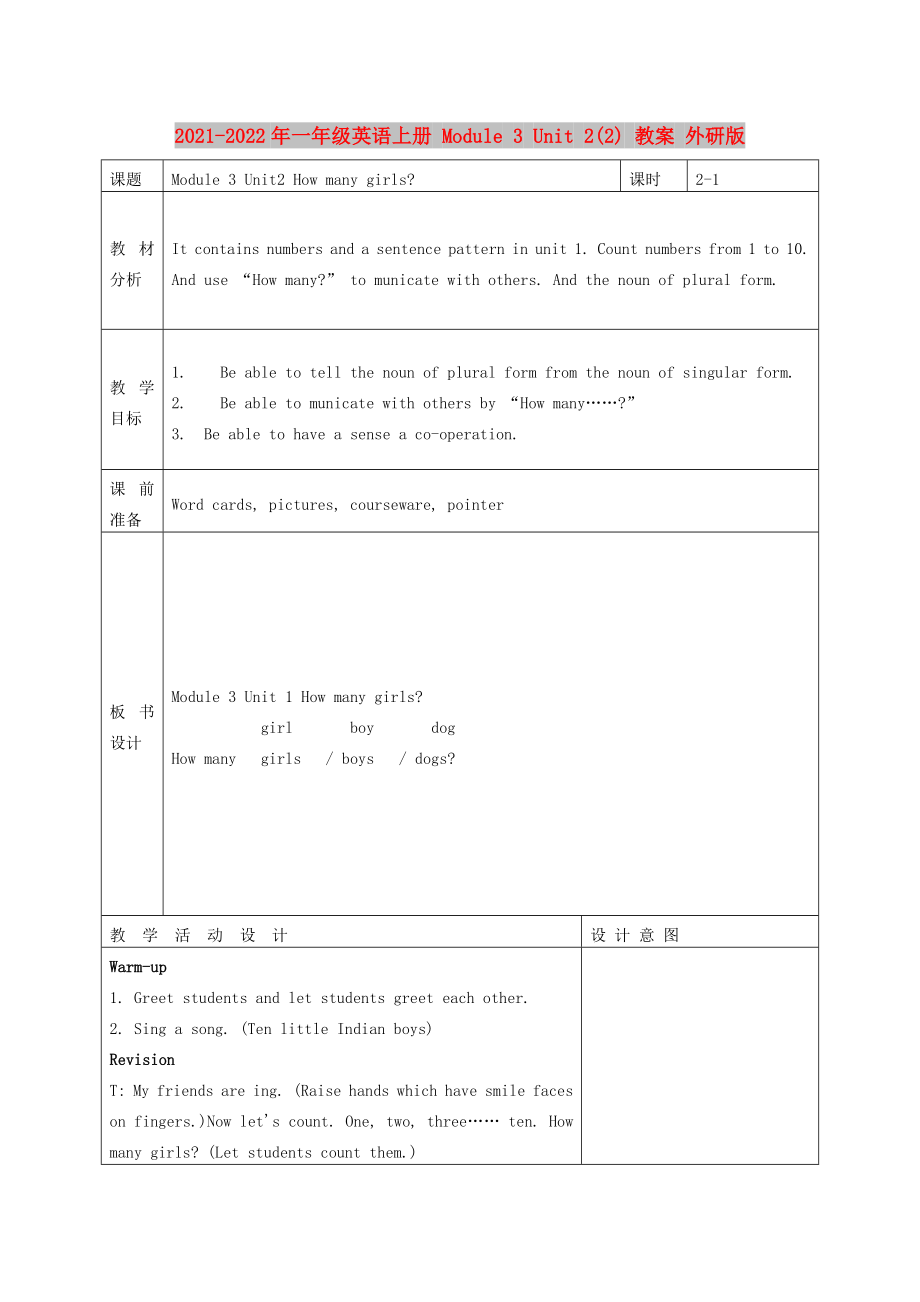《2021-2022年一年級(jí)英語(yǔ)上冊(cè) Module 3 Unit 2(2) 教案 外研版》由會(huì)員分享��,可在線閱讀�,更多相關(guān)《2021-2022年一年級(jí)英語(yǔ)上冊(cè) Module 3 Unit 2(2) 教案 外研版(6頁(yè)珍藏版)》請(qǐng)?jiān)谘b配圖網(wǎng)上搜索。
1���、2021-2022年一年級(jí)英語(yǔ)上冊(cè) Module 3 Unit 2(2) 教案 外研版
課題
Module 3 Unit2 How many girls?
課時(shí)
2-1
教材分析
It contains numbers and a sentence pattern in unit 1. Count numbers from 1 to 10. And use “How many?” to municate with others. And the noun of plural form.
教學(xué)目標(biāo)
1.??Be able to tell the noun of plural fo
2�����、rm from the noun of singular form.
2.??Be able to municate with others by “How many……?”
3.?Be able to have a sense a co-operation.
課前準(zhǔn)備
Word cards, pictures, courseware, pointer
板書設(shè)計(jì)
?
Module 3 Unit 1 How many girls?
girl boy dog
How many girls / boys / dogs?
?
3��、
教 學(xué) 活 動(dòng) 設(shè) 計(jì)
設(shè) 計(jì) 意 圖
Warm-up
1. Greet students and let students greet each other.
2. Sing a song. (Ten little Indian boys)
Revision
T: My friends are ing. (Raise hands which have smile faces on fingers.)Now let's count. One, two, three…… ten. How many girls? (Let students count them.)
S
4���、: Nine.
T: yes. Nine girls.
Instruct students to count : one girl, two girls, three girls……) Then, How many boys?
S: One boy.
Presentation
1. Show the class some pictures on the page of students' book .To show them the difference of “girl” and “girls”.
2. Let students practice to ask and
5、answer “How many” in chains.
3. Listen to the tape and repeat.
4. Ask some questions about things in our classroom. ( How many books/pencils……?)
Practice
1.Group co-operation
municate with your partner.
2. Activity: Group of girls and boys. When teacher says “girl” , Each girl stands up. Whe
6�、n teacher says “girls”, Many girls stand together.
Consolidation and extension
1. group co-operation .Practice “How many? ……”
2. Sing a song (Ten little Indian boys)
3. Finish the activity book.
?
?
?
?
?
?
?
?
?
?
?
?
?
?
?
When students say “one boys” , teacher waves her hand
7、and show no “s”. In order to give them a deep impression.
?
?
?
?
?
?
?
?
?
?
?
作 業(yè)
設(shè) 計(jì)
1.? Singing and dancing the song.
2.? Count how many things in your house.
?
教 學(xué)
反 思
本節(jié)課的重點(diǎn)是復(fù)數(shù)的教學(xué)�,所以我采取了直觀的教學(xué)方法,通過(guò)數(shù)一數(shù)班級(jí)男生女生的數(shù)量來(lái)學(xué)習(xí)復(fù)數(shù)�,如one boy , two boys, three boys…… 同時(shí)注意糾正學(xué)生的發(fā)音�,boys 和girls 后
8�����、面的s要發(fā)/z/,效果不錯(cuò)����,孩子們能夠理解并自己數(shù)一數(shù)。
附送:
2021-2022年一年級(jí)英語(yǔ)上冊(cè) Uint5 Numbers(1)教案 人教新起點(diǎn)
教學(xué)目標(biāo)
1.能夠在本單元涉及的情景條件下聽懂并說(shuō)出英語(yǔ)數(shù)字1~10���。
2.能夠說(shuō)有關(guān)數(shù)字的歌謠。
3.能夠初步用英語(yǔ)詢問年齡并能表達(dá)自己的年齡�。
4.能夠聽懂并初步用英語(yǔ)進(jìn)行10以內(nèi)的加法計(jì)算。
5.能夠聽懂并初步用英語(yǔ)說(shuō)房間號(hào)和電話號(hào)碼��。
6.能夠識(shí)記幾個(gè)重要的電話號(hào)碼����。
7.能夠知道在用手勢(shì)表達(dá)數(shù)字時(shí),中外表達(dá)方法是不同的���。
課前準(zhǔn)備
1.教學(xué)掛圖�。
2.教學(xué)投影片����。
3.教學(xué)錄音磁帶�����。
9����、4.?dāng)?shù)字卡片(教師�����、學(xué)生各自準(zhǔn)備)����。
5.圖片和實(shí)物(用于學(xué)生數(shù)數(shù))。
6.制作五角星的材料和工具��,如剪刀��,紙等���。
教學(xué)內(nèi)容
A. Look, listen and chant.
1.通過(guò)歌謠和國(guó)旗上的五顆星�����,引入英語(yǔ)數(shù)字1~5�����。
2.讓學(xué)生用英語(yǔ)數(shù)一數(shù)圖上的小朋友�����。
B. Let's make and chant.
1.組織學(xué)生進(jìn)行五角星的小制作�����。
2.聽錄音��,手指教材上的星星數(shù)數(shù):one star, two stars...
3.本部分的錄音已涉及到數(shù)字6�����,如果教師認(rèn)為本課的數(shù)字應(yīng)限制在1~5的范圍內(nèi)���,就可以使用補(bǔ)充錄音材料。
4.本部分將涉及到單詞的復(fù)數(shù)形
10��、式����,不必講解�����,只要能正確說(shuō)出即可�����。
教學(xué)建議
1.教師可以選擇多種方法引入英語(yǔ)數(shù)字1-5的學(xué)習(xí)�,以下幾種方法供參考:
(1)利用教材給出的情景����。如,教師可以使用天安門升旗儀式的錄像片引出鮮艷的五星紅旗�����,然后問:What do you see in the picture? A flag.This is our national flag.There are some yellow stars on it.How many stars? How many stars do you see? Let's count.One, two, three, four, five.We see f
11�����、ive yellow stars.
(2)利用看圖說(shuō)話的形式引入1~5英文數(shù)字的學(xué)習(xí)��。
①出示圖畫��,畫面內(nèi)容應(yīng)該是學(xué)生會(huì)說(shuō)的單詞,如:文具或動(dòng)物�����。畫面呈現(xiàn)的內(nèi)容應(yīng)該包含1~5的數(shù)量�,如one rabbit, two monkeys, three birds..., 可以利用第21課A項(xiàng)的掛圖。
②請(qǐng)學(xué)生說(shuō)一說(shuō)看到了什么���?T: What do you see in the picture? Ss: ...
③教師接著指圖問:How many rabbits (monkeys, birds, ... )do you see��?此時(shí)學(xué)生并不會(huì)回答���,教師可以自問自答:We see one ra
12、bbit, two monkeys, three birds.... 教師在自問自答的同時(shí)將數(shù)字1~5出示在相應(yīng)的動(dòng)物圖下��。
④教師指圖重復(fù)說(shuō)出數(shù)字1~5��。
(3)利用學(xué)習(xí)用具���。如教師出示鉛筆,對(duì)學(xué)生說(shuō):I have five pencils.One, two, three, four, five, five pencils.Show me your pencils.How many pencils do you have�?在學(xué)生出示自己的鉛筆時(shí),教師幫助學(xué)生說(shuō)出數(shù)詞�����。
(4)利用復(fù)習(xí)導(dǎo)入數(shù)詞的學(xué)習(xí)。如:T: Show me your pencil (ruler, eraser, ...
13��、 )T: Show me two pencils.教師在說(shuō)的同時(shí)出示相應(yīng)數(shù)量的物品����,并幫助學(xué)生說(shuō)出數(shù)詞。
2.引入數(shù)詞的學(xué)習(xí)后��,教師應(yīng)先從聽力上幫助學(xué)生熟悉1~5的英文表達(dá)��。以下方法供參考:
(1)看圖聽歌謠���。教師在學(xué)生聽歌謠的同時(shí)做出相應(yīng)的形體動(dòng)作�。
(2)TPR活動(dòng)�。學(xué)生根據(jù)聽到的舉起相應(yīng)數(shù)量的物品或數(shù)字卡片等。
3.學(xué)生初步聽錄音說(shuō)歌謠��。教師可以根據(jù)需要替換A項(xiàng)歌謠中stars一詞�����。
4.教師幫助學(xué)生數(shù)周圍的物品,如學(xué)習(xí)用具�����,直觀理解和記憶數(shù)字1~5 的英語(yǔ)表達(dá)���。如教師手拿鋼筆或書說(shuō):One pencil (book), two pencils (books)..., 或教師手
14����、拿實(shí)物問How many books? 學(xué)生邊數(shù)邊答One, two, three....
5.本課的B部分應(yīng)當(dāng)組織小組活動(dòng)進(jìn)行五角星的制作��。在制作過(guò)程中�,學(xué)生可以邊做邊進(jìn)行說(shuō)唱活動(dòng)。教師必須在學(xué)生進(jìn)行小組活動(dòng)時(shí)進(jìn)行指導(dǎo)和行為調(diào)整���。
6.如果學(xué)生的接受能力較強(qiáng)��,教師可以補(bǔ)充材料中的歌謠�����。
7.錄音材料:
A項(xiàng):CHANT
How many stars can you see?
Can you count them 1, 2, 3?
I see 4.
5 I see.
Can you count the stars with me?
B項(xiàng):CHANT
One star,
15��、
Two stars,
Three stars, four.
One, two,
Three, four,
Five stars more.
8.補(bǔ)充材料:
A項(xiàng):CHANT 1
Stars high,
Stars low,
1, 2, 3,
Stars grow.
Stars low,
Stars high,
3, 4, 5,
In the sky.
CHANT 2
1 little,
2 little,
3 little stars.
3 little,
4 little,
5 little stars.
1, 2,
16、3, 4, 5, I see.
Can you count the stars with me?
B項(xiàng):CHANT
One star, two stars, three stars, four.
Five stars, six stars.
Are there more?
課堂學(xué)習(xí)評(píng)價(jià)
1.引導(dǎo)學(xué)生把掌握英語(yǔ)數(shù)字1~5的情況用 和 符號(hào)記入學(xué)習(xí)檔案。
2.教師具體而簡(jiǎn)要地記錄學(xué)生當(dāng)堂表現(xiàn):
-積極學(xué)習(xí)歌謠的學(xué)生在全班占多大比例��?
-各小組制作五角星的表現(xiàn)如何�����?
-踴躍地做出話語(yǔ)反映的學(xué)生有多少人��?他們是誰(shuí)��?
-有沒有其它特別的表現(xiàn)��?
3.本課對(duì)學(xué)生掌握學(xué)習(xí)內(nèi)容情況的評(píng)定方法:
-教師播放錄音��,請(qǐng)學(xué)生聽錄音��,并根據(jù)聽到的錄音做手勢(shì)�����。教師進(jìn)行現(xiàn)場(chǎng)記錄���。
-鼓勵(lì)學(xué)生聽錄音模仿單詞����,同時(shí)用手勢(shì)表達(dá)出來(lái)。教師進(jìn)行現(xiàn)場(chǎng)記錄���。
-學(xué)生聽歌謠并進(jìn)行表演��,檢查學(xué)生是否掌握有關(guān)數(shù)字的單詞����。
-教師讀單詞��,讓學(xué)生舉出單詞卡片��。也可讓學(xué)生以pair work或group work的形式
進(jìn)行活動(dòng)����。教師進(jìn)行現(xiàn)場(chǎng)記錄。
-教師出示單詞卡片�����,請(qǐng)學(xué)生快速說(shuō)出有關(guān)數(shù)字單詞���。教師進(jìn)行現(xiàn)場(chǎng)記錄���。
 2021-2022年一年級(jí)英語(yǔ)上冊(cè) Module 3 Unit 2(2) 教案 外研版
2021-2022年一年級(jí)英語(yǔ)上冊(cè) Module 3 Unit 2(2) 教案 外研版

